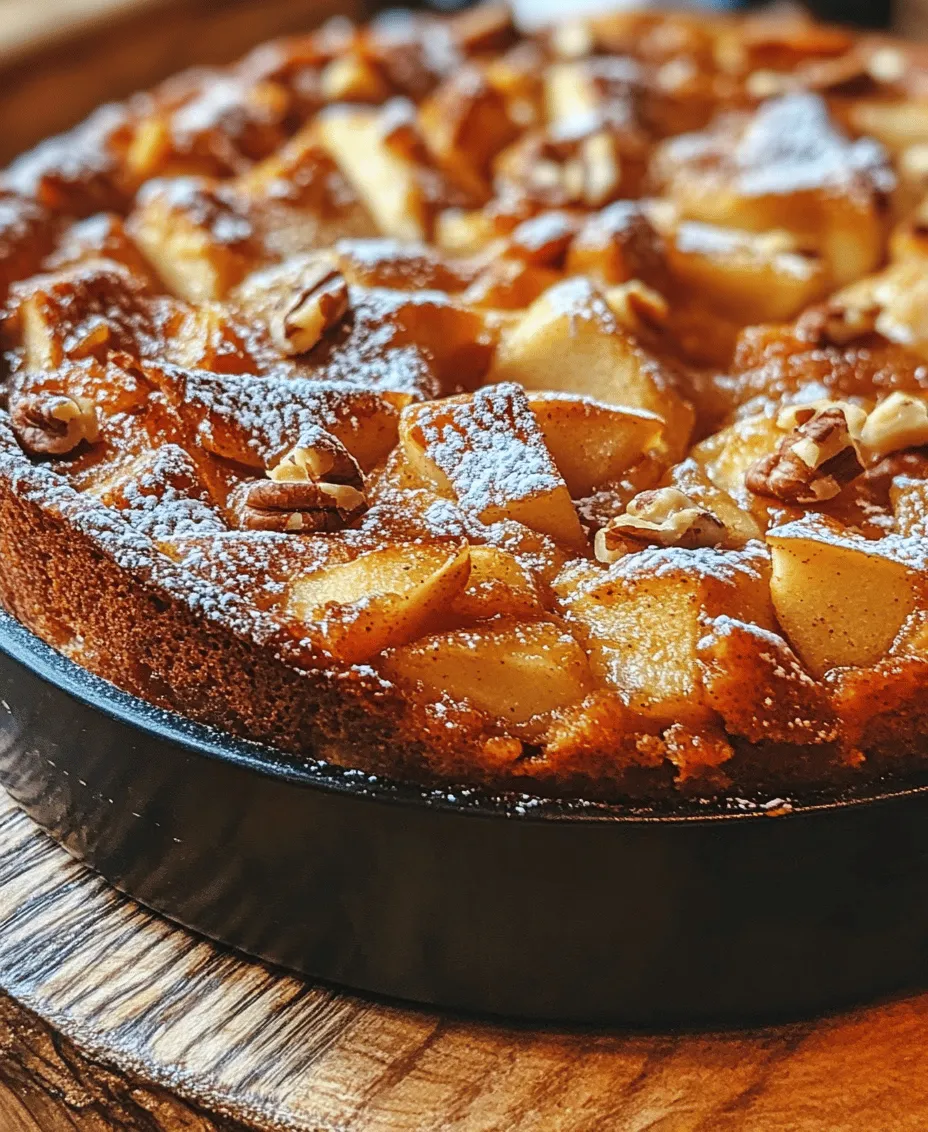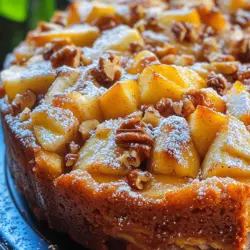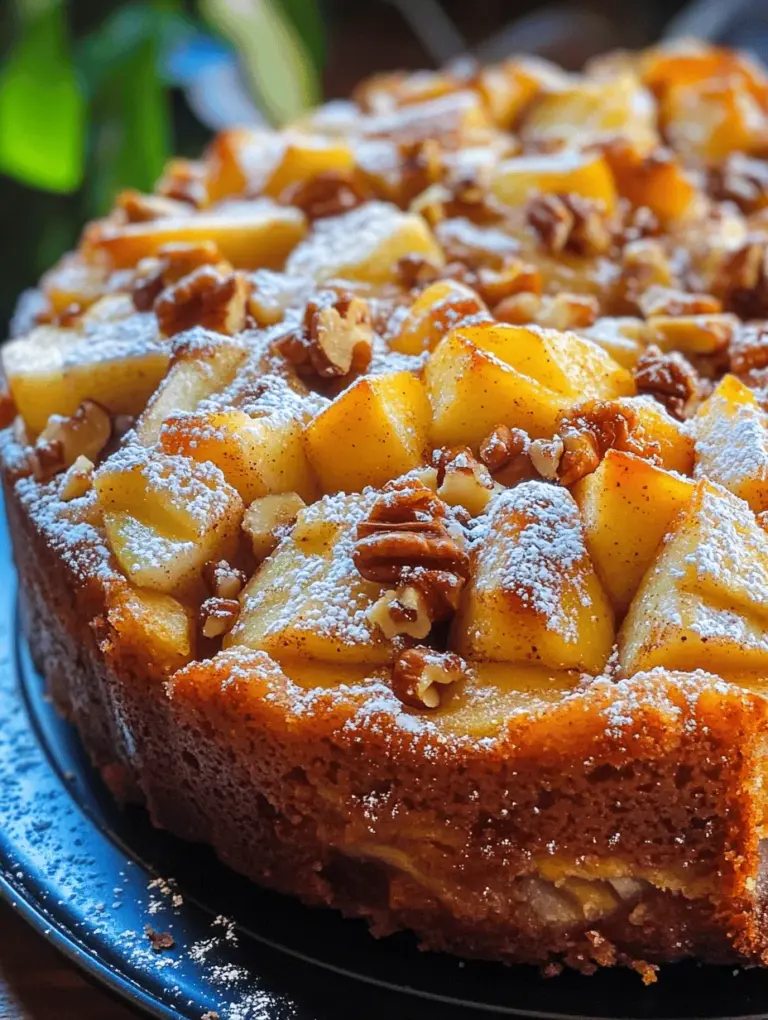Apple Dapple Cake is a delightful dessert that captures the essence of autumn with its rich flavors and comforting texture. This cake is not just a treat for the taste buds; it’s a nostalgic experience that many home bakers cherish. With the combination of fresh apples, crunchy nuts, and warm spices, Apple Dapple Cake has a unique charm that makes it a staple in many households, especially during the cooler months. This cake’s versatility allows it to transition seamlessly from a cozy family gathering to a festive holiday dessert, making it a favorite for any occasion.
The appeal of Apple Dapple Cake lies in its ability to evoke memories of home and hearth. Many people remember watching their mothers or grandmothers prepare this cake, filling the kitchen with the mouthwatering aroma of baked apples and cinnamon. The recipe has been passed down through generations, evolving over time while still retaining its classic essence. Whether you enjoy it for breakfast, as a snack, or for dessert, Apple Dapple Cake promises satisfaction with every bite.
Understanding the Ingredients
To create the perfect Apple Dapple Cake, understanding the ingredients is essential. Each component plays a significant role in the cake’s flavor, texture, and overall success.
Fresh Apples
The star of the show in Apple Dapple Cake is undoubtedly the apples. Choosing the right variety can make a significant difference in the cake’s taste and texture. Popular options for baking include Granny Smith and Honeycrisp apples.
– Granny Smith: These tart, green apples are a classic choice for baking due to their firm texture and refreshing acidity. Their tartness balances the sweetness of the sugar in the cake, providing a beautiful contrast that enhances the overall flavor.
– Honeycrisp: Known for their sweet, juicy flavor and crisp texture, Honeycrisp apples also make an excellent addition to Apple Dapple Cake. They add a lovely natural sweetness and moisture that complements the spices perfectly.
Using fresh apples is crucial, as they contribute not only flavor but also moisture and texture to the cake. Fresh apples provide a crisp bite that contrasts beautifully with the soft, tender crumb of the cake, ensuring each slice is a delightful experience.
Sugars: Granulated vs. Brown
The type of sugar you use can significantly affect the cake’s flavor and texture. Both granulated and brown sugars have their unique characteristics.
– Granulated Sugar: This is the most common sugar used in baking. It provides sweetness and helps create a light and airy texture in baked goods. However, it lacks the depth of flavor that brown sugar offers.
– Brown Sugar: Made by adding molasses to granulated sugar, brown sugar is darker and has a richer flavor profile. It enhances the moisture retention of the cake, giving it a denser and more fudgy texture. The molasses in brown sugar also adds a hint of caramel flavor, which pairs beautifully with the apples and spices.
Combining both sugars in your Apple Dapple Cake can provide the best of both worlds—sweetness and depth, resulting in a more complex flavor profile that is exceptionally satisfying.
Eggs and Oil
Eggs and oil are essential for achieving the right texture in Apple Dapple Cake.
– Role of Eggs: Eggs act as a binding agent, helping to hold the ingredients together. They also contribute to the cake’s moisture and richness. When beaten, eggs can incorporate air into the batter, which helps the cake rise and achieve a light, fluffy texture.
– Benefits of Vegetable Oil: Using vegetable oil in your cake batter can lead to a tender crumb that is moist and delicious. Oil retains moisture better than butter, which can dry out during baking, making it an excellent choice for cakes that need to stay fresh for a longer time.
Spices and Leavening Agents
The right spices and leavening agents elevate the flavor of Apple Dapple Cake.
– Baking Soda and Baking Powder: These leavening agents are crucial for the cake’s rise. Baking soda requires an acidic ingredient to activate, which is often provided by the tartness of apples. Baking powder, on the other hand, contains both an acid and a base and can create lift in the batter. Using a combination of both can yield the perfect balance for a light and airy cake.
– Cinnamon: Perhaps the most aromatic spice in this recipe, cinnamon brings warmth and a comforting flavor that complements the sweetness of the apples. Its fragrant notes evoke the essence of autumn and add depth to the cake.
Optional Add-ins: Nuts and Raisins
Adding nuts and raisins to your Apple Dapple Cake can introduce additional flavors and textures.
– Nuts: Chopped walnuts or pecans add a delightful crunch and a nutty flavor that contrasts beautifully with the softness of the cake. They also provide beneficial nutrients, such as healthy fats and protein, enhancing the nutritional profile of the dessert.
– Raisins: Sweet and chewy, raisins can bring a burst of sweetness and an additional layer of flavor. Soaking them in warm water or apple juice before adding them to the batter can enhance their flavor and ensure they remain plump and juicy.
The beauty of Apple Dapple Cake is its flexibility; you can personalize the recipe to suit your tastes. Feel free to experiment with different nuts, dried fruits, or even a hint of citrus zest to create a unique version that is distinctly yours.
Preparation Steps Explained
Now that we have a solid understanding of the ingredients, let’s move on to the preparation steps to get that delicious Apple Dapple Cake into the oven.
Preheating the Oven
Before you start mixing the ingredients, it’s essential to preheat your oven. Proper oven temperature is crucial for optimal baking results. Set your oven to 350°F (175°C), which is the standard temperature for many cake recipes. Preheating the oven ensures that the cake rises correctly and bakes evenly, preventing a dense or undercooked center.
Preparing the Apples
The first step in preparing your Apple Dapple Cake is to get the apples ready. Here’s how to do it:
1. Washing and Peeling: Start by washing your apples thoroughly under running water to remove any dirt or wax. Once clean, peel the apples using a vegetable peeler or a sharp knife.
2. Chopping: Core and chop the apples into small, bite-sized pieces. The size of the apple pieces will affect the texture of the cake, so aim for uniformity to ensure even distribution throughout the batter.
3. Sugaring the Apples: To enhance the flavor of the apples, sprinkle them with a bit of sugar (about 1-2 tablespoons) and let them sit for approximately 10-15 minutes. This resting period allows the apples to release some of their natural juices, which will intensify their flavor and create a lovely syrupy mix.
Mixing Wet Ingredients
While the apples are resting, you can start mixing the wet ingredients. This step lays the foundation for a well-blended batter.
1. In a large mixing bowl, combine the eggs: Crack the eggs into the bowl and beat them lightly until they are well mixed. This will help incorporate air, contributing to the cake’s lightness.
2. Add the Oil: Pour in the vegetable oil and mix it in with the eggs until fully combined. The oil will contribute to the moisture and tenderness of the cake.
3. Incorporate Sugars: Gradually add both granulated and brown sugars to the wet mixture, whisking until the sugars are dissolved and the mixture is smooth. The combination of sugars will add complexity to the flavor, creating a perfect balance of sweetness.
As you mix the wet ingredients, the aromas of cinnamon and fresh apples will begin to waft through your kitchen, building anticipation for the delicious cake to come.
With these initial steps completed, you are well on your way to creating a memorable Apple Dapple Cake. The next part of this recipe will guide you through the remaining steps, ensuring you achieve the perfect bake. Stay tuned as we explore the mixing of dry ingredients, incorporating the apples, and the baking process that will bring your cake to life.

Best Practices for Whisking and Combining Ingredients
Whisking is more than just mixing; it’s a critical step in creating a light and airy texture in your Apple Dapple Cake. Begin by using a large mixing bowl to give your ingredients enough space to combine without splattering. A balloon whisk or an electric mixer on medium speed is best for incorporating air into your batter, which helps create those delightful fluffy layers.
When whisking eggs and sugar together, aim for a frothy texture. This is essential as it helps to trap air, leading to a lighter cake. Whisking until the mixture turns pale and slightly thickened is a good visual cue that you’ve achieved the right consistency. The frothy state not only contributes to the cake’s lift but also adds a beautiful structure that holds up well when you incorporate the dry ingredients.
Combining Dry Ingredients
Combining dry ingredients is where we set the foundation for our cake. Begin by measuring out your flour, baking soda, baking powder, cinnamon, and salt. It’s crucial to sift these ingredients together. Sifting helps eliminate lumps and ensures that the leavening agents are evenly distributed throughout the flour. This is particularly important for baking powder and baking soda, as uneven distribution can lead to inconsistent rising.
The benefits of sifting go beyond just aesthetics; it also aerates the flour, which results in a lighter cake. If you skip this step, you risk dense and heavy results that can overshadow the lovely apple flavor you’re aiming for.
Merging Wet and Dry Mixtures
When it comes time to combine your wet and dry mixtures, it’s essential to do so carefully. Begin by creating a well in the center of your dry ingredients and pour the wet mixture into it. This technique allows for a gradual incorporation, reducing the risk of overmixing.
Overmixing is a common mistake that can lead to a tough cake. The science behind this is that excessive mixing activates gluten in the flour, which can create a chewy texture rather than the tender crumb we desire. Mix just until you see no dry streaks of flour, and don’t worry if there are a few lumps in the batter; it’s better to have a slightly lumpy batter than a smooth, overmixed one.
The Science Behind Creating a Tender Cake
The goal of any good baker is to create a tender cake, and understanding the science behind it can make all the difference. The balance of fat, sugar, and flour is crucial. In this recipe, the oil allows for moisture and tenderness, while sugar contributes to the cake’s structure and sweetness. The trick is to use the right proportions and mixing techniques.
Additionally, the inclusion of apples not only adds flavor but also moisture, enhancing the overall texture. The natural sugars in apples caramelize during baking, resulting in a beautiful golden-brown crust. Each of these components plays a significant role in achieving the desired cake consistency.
Adding Apples and Extras
Once your batter is mixed, it’s time to fold in the stars of the show: the apples, nuts, and raisins. Use a rubber spatula or wooden spoon to gently fold in these ingredients. The technique of folding is essential as it minimizes deflating the batter, ensuring that your cake retains its airy quality.
When adding apples, it’s best to dice them into small, even pieces to ensure they distribute evenly throughout the batter. For the nuts and raisins, a light toss in a bit of flour before adding them to the batter can help prevent them from sinking to the bottom. This simple step ensures that your extras are well-distributed, providing flavor and texture in every bite.
Baking the Cake
Pouring and Smoothing the Batter
With everything combined, pour the batter into a greased and floured cake pan. It’s essential to smooth the top with a spatula to create an even surface. An even batter ensures that your cake rises uniformly, preventing any doming or uneven baking, which can affect presentation.
Baking Time and Testing for Doneness
The baking time for Apple Dapple Cake is typically around 50 to 60 minutes, but this can vary based on your oven and the size of your cake pan. To test for doneness, insert a toothpick into the center of the cake. If it comes out clean or with a few moist crumbs, your cake is ready. Additionally, you can lightly press the top of the cake; if it springs back, it’s a good indication that it’s done.
Understanding the signs of readiness is essential. Look for a golden-brown top and the edges pulling slightly away from the sides of the pan. These visual cues indicate that your cake has baked thoroughly.
Cooling Techniques
After baking, let your cake cool in the pan for about 15 minutes. This step allows it to set and makes it easier to remove without breaking. After that, you can transfer it to a wire rack to cool completely. Cooling on a wire rack is crucial as it allows air to circulate around the cake, preventing it from becoming soggy.
Cooling in the pan can lead to a denser texture, as the cake continues to cook from residual heat. It can also affect the flavor, as a properly cooled cake retains its moistness without becoming overly wet.
Serving Suggestions
Presentation Ideas
For an elegant touch, dust your cooled Apple Dapple Cake with powdered sugar before serving. This simple decoration adds a visual appeal and a hint of sweetness that complements the cake beautifully. You can also consider serving it with a drizzle of caramel sauce or a scoop of vanilla ice cream for a delightful contrast of flavors and textures.
Pairing with Beverages
Pairing your Apple Dapple Cake with the right beverage can elevate the experience. A cup of freshly brewed coffee or a fragrant herbal tea complements the warm spices in the cake. For something a bit more indulgent, consider a glass of dessert wine or a sweet cider, which can harmonize wonderfully with the apple flavors.
Storing Leftover Cake
To maintain the freshness of your leftover Apple Dapple Cake, store it in an airtight container at room temperature for up to three days. If you need to keep it longer, consider refrigerating it, but ensure it’s well-wrapped to prevent it from drying out. You can also freeze the cake for up to three months, making it easy to enjoy at a later date.
Nutritional Information
Apple Dapple Cake offers a delightful mix of nutrients, primarily from apples, nuts, and whole grains if you opt for whole wheat flour. Apples provide dietary fiber and vitamin C, while nuts offer healthy fats and protein. If you’re looking to make dietary adjustments, consider using gluten-free flour blends or nut-free options like sunflower seeds, making this cake accessible to those with dietary restrictions.
Conclusion
The joy of baking an Apple Dapple Cake lies not only in its delicious flavor and comforting aroma but also in the memories it creates. This cake is perfect for family gatherings, special occasions, or simply a cozy evening at home. The combination of tender cake, sweet apples, and warm spices can evoke feelings of nostalgia and warmth, making it a beloved recipe to share with loved ones.
Encouraging you to try this recipe means inviting you to experience the joy of baking and sharing a slice of comfort. The act of creating something delicious can foster connections and bring joy to both the baker and those who enjoy the fruits of their labor. So, gather your ingredients, embrace the process, and let the Apple Dapple Cake become a cherished tradition in your kitchen.

